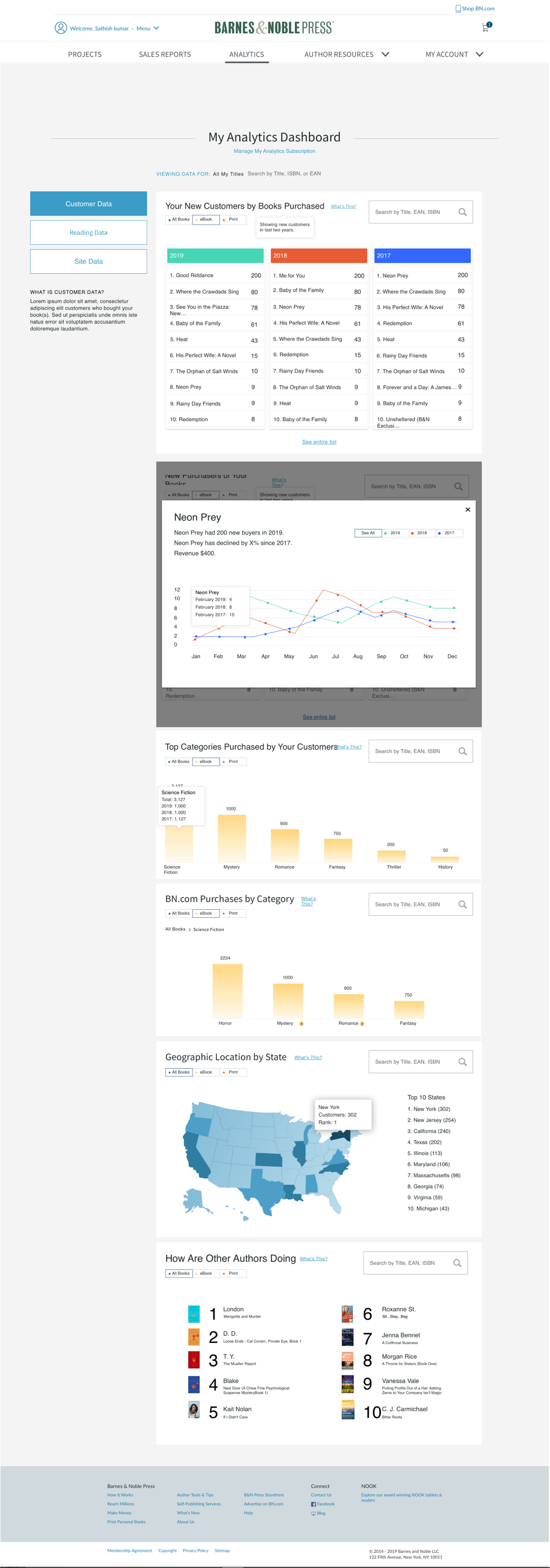BN Press
Self-publishing service that enables you to publish and sell print or ebooks directly to our millions of readers. Whether you’re a seasoned or first-time author or want to print a beautiful book for personal use, Barnes & Noble Press helps you create your book your way. We’re here to help independent authors and content creators succeed by using the expertise and resources of Barnes & Noble.
-
Problem
Authors don’t have a visibility into how their products are performing on B&N or any other content publishing platform.
-
Goal
Authors don’t have a visibility into how their products are performing on B&N or any other content publishing platform.
-
Solution
Authors don’t have a visibility into how their products are performing on B&N or any other content publishing platform.
An analytics dashboard enables authors to learn and act on data-driven insights. Authors can track customer, reading, and site data.
Customer data provides insights into the number of purchases per book throughout the years, popular genres, location, and other successful authors.
Reading data outlines the behavior of customers reading books.
Site data shows customers' channels to get to the book product page.
Research
Goal
The goal of the user research was to learn about our competitors, uncover what would make authors be interested in the product and what are some of the features they would be looking for.
Outcome
There is currently no product that gives them data on their books/customers.
Authors want to see how their series/books performs throughout the years (are their promotions boosting their sales?).
Authors want to see who’s their competition or authors that they could collaborate with.
How well are their books being read; are readers completing their books? how long does it takes them to read a book? how long does it take to start reading a book after they have purchased it?
What People Are Saying
“I want to be able to see who are authors in the field who do well so I can collaborate with them, and potentially get more exposure through them”
“There is nothing out there that helps me track my sales. No publishing tool that I use gives me any data”
“It would be nice to see how my book sales are performing throughout the years.”
First iteration
In this first iteration I put together graphs based on user research and secondary research that I also did to identify industry best practices on data viz.
User Testing
We conducted six moderated usability testing with existing customers for the first iteration. The goal was to gauge how people react to the product, and also how they interact with it. I wanted to know if they understand every graph and find it valuable.
Based on the test I learned that there were issues with few graphs especially on the Reading Data tab as well as the “Other Authors” section on the Customer Data page.
I worked on a couple of versions constantly testing and iterating based on the results, because I wanted to get to a place where all the graphs are easy to understand and provide value to authors.
More iterations
Reading data went through few rounds of iterations, because every time I tested it I didn’t get the results that I was hoping for. With every new design it got simpler each time.











MVP
After rounds of iterations and discussing graphs with developers, this was my final design for the MVP. The dashboard is divided into three categories: customer, reading, and site data.
Customer data will allow authors to learn more about what kinds of books bring in more revenue, which part of the country they are doing well in, and who other authors they can potentially collaborate with.
Reading data gives more insights into customer behavior, including everything from how long it takes to read a book to how soon customers start reading it after purchasing it.
Site data shows which promotional channels are being used, how customers land on author pages, and the percentage of readers who buy books after discovering the author.


